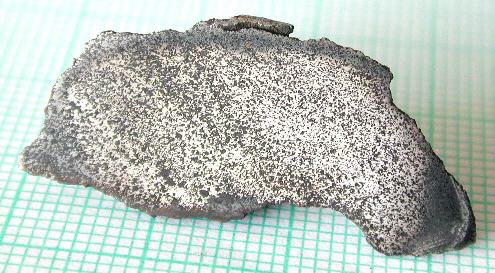Isheyevo
CH/CBb
(transitional between CH3 chondriteChondrites are the most common meteorites accounting for ~84% of falls. Chondrites are comprised mostly of Fe- and Mg-bearing silicate minerals (found in both chondrules and fine grained matrix), reduced Fe/Ni metal (found in various states like large blebs, small grains and/or even chondrule rims), and various refractory inclusions (such Click on Term to Read More and CBb bencubbinite)
Found October 2003
53° 37′ N., 56° 20′ E. A single fusion-crusted meteoriteWork in progress. A solid natural object reaching a planet’s surface from interplanetary space. Solid portion of a meteoroid that survives its fall to Earth, or some other body. Meteorites are classified as stony meteorites, iron meteorites, and stony-iron meteorites. These groups are further divided according to their mineralogy and Click on Term to Read More weighing 16.7 kg was found in a field by a farmer while operating a tractor. The location of the findMeteorite not seen to fall, but recovered at some later date. For example, many finds from Antarctica fell 10,000 to 700,000 years ago. Click on Term to Read More was in the Ishimbai region of Bashkortostan, Russia, near the village of Isheyevo. In September of 2004, a sample was submitted for analysis to the Vernadsky Institute, Russian Academy of Sciences, Moscow (M. Ivanova), while additional analysis was conducted at Michigan State University (A. Ulianov). Although a classification of CBb was INITIALLY agreed upon and submitted to the Nomenclature Committee, Isheyevo exhibits mineralogical characteristics intermediate between CH and CBb chondritesChondrites are the most common meteorites accounting for ~84% of falls. Chondrites are comprised mostly of Fe- and Mg-bearing silicate minerals (found in both chondrules and fine grained matrix), reduced Fe/Ni metal (found in various states like large blebs, small grains and/or even chondrule rims), and various refractory inclusions (such Click on Term to Read More and a classification of CH/CBb is recommended.

Photos shown courtesy of Olga Dobrova—Rus Meteorites A unique group of 26Al-poor relict CAIs consisting of highly refractory spinel+grossite+hibonite has also been identified in Isheyevo. These are embedded in 26Al-poor, magnesian, porphyritic host chondrules within the metal-poor lithology (Krot et al., 2007). This was an early-formed population of CAIs that must have been extant in the chondrule-forming region prior to the formation of the host magnesian porphyritic chondrules—a region inferred to have been distant in time and/or proximity from that of all other chondrule-bearing chondrite groups. Since the O-isotopic values of the CAIs present in CB chondrites plot along the CCAM line instead of the CR trend line, they represent primordial 26Al-poor molecular cloudAn interstellar gas cloud that is dense enough to allow the formation of molecules and comprised of a cold dense complex mixture of interstellar gas and dust roughly 75% hydrogen and 21-24% helium. Clouds contain trace amounts of other molecules, of which well over 100 different types have now been Click on Term to Read More material rather than condensates from the impact vapor plume (Fedkin et al., 2015; Van Kooten et al., 2016). Schematic of the Evolution Scenario of the Early Solar SystemThe Sun and set of objects orbiting around it including planets and their moons and rings, asteroids, comets, and meteoroids.
A. Giant Molecular Cloud ⇒ B. Protostars ⇒ C. Proto-Sun and Protoplanetary DiskFlattened and rotating disk of dense gas and dust/solids orbiting a young star from which planets can eventually form. Click on Term to Read More
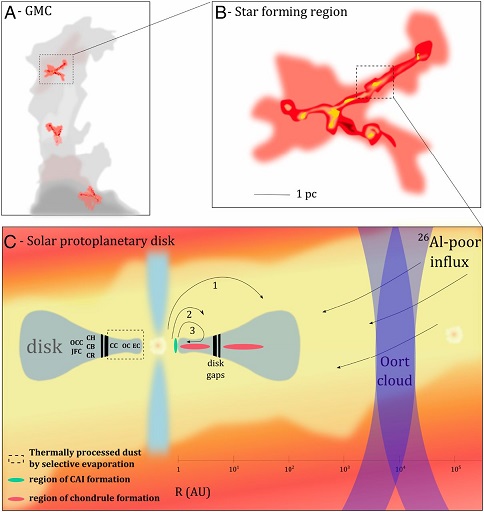
click on photo for a magnified view Diagram credit: Van Kooten et al., PNAS, vol. 113, no. 8 (2016, open access link)
‘Isotopic evidence for primordial molecular cloud material in metal-rich carbonaceous chondrites’
(https://doi.org/10.1073/pnas.1518183113) Chondrules in the two lithologies of Isheyevo are ferromagnesian and Al-rich, but the chondruleRoughly spherical aggregate of coarse crystals formed from the rapid cooling and solidification of a melt at ~1400 ° C. Large numbers of chondrules are found in all chondrites except for the CI group of carbonaceous chondrites. Chondrules are typically 0.5-2 mm in diameter and are usually composed of olivine Click on Term to Read More textures are mostly distinct between the two lithologies. The metal-rich lithology contains mostly magnesian cryptocrystallineCrypto meaning "hidden" refers to a rock texture in which individual crystals are too small to be distinguished even using a standard petrographic microscope. Crystals are typically less than a few μm in size - any smaller and the texture would be considered amorphous. Among sedimentary terrestrial rocks, chert and Click on Term to Read More (some oxidizedOxidation and reduction together are called redox (reduction and oxidation) and generally characterized by the transfer of electrons between chemical species, like molecules, atoms or ions, where one species undergoes oxidation, a loss of electrons, while another species undergoes reduction, a gain of electrons. This transfer of electrons between reactants Click on Term to Read More, FeO-rich [type-II]) and skeletal olivineGroup of silicate minerals, (Mg,Fe)2SiO4, with the compositional endpoints of forsterite (Mg2SiO4) and fayalite (Fe2SiO4). Olivine is commonly found in all chondrites within both the matrix and chondrules, achondrites including most primitive achondrites and some evolved achondrites, in pallasites as large yellow-green crystals (brown when terrestrialized), in the silicate portion Click on Term to Read More chondrules considered to have formed as gas–melt condensates in an impact-generated plume. This lithology contains a lower abundance of barred chondrules formed from a melt component of the plume. By contrast, the metal-poor lithology contains mostly various types of olivine and pyroxene porphyritic chondrules (primarily reducedOxidation and reduction together are called redox (reduction and oxidation) and generally characterized by the transfer of electrons between chemical species, like molecules, atoms or ions, where one species undergoes oxidation, a loss of electrons, while another species undergoes reduction, a gain of electrons. This transfer of electrons between reactants Click on Term to Read More, FeO-poor [type-I]) which formed by melting of precursor material in the solar nebula (Krot et al., 2006; Krot and Kazuhide, 2008). Some porphyritic olivine–pyroxene chondrules are zoned like those in CH chondrites (Ivanova et al., 2005), and the Al-rich chondrules which are present are also more like those in CH chondrites than in CB chondrites. Another group of highly zoned chondrules present in Isheyevo differ from those in CH chondrites in that they contain phyllosilicate rims (Ivanova and Lorenz (2006). These highly zoned chondrules likely formed in a multistage event begining with condensation of a Mg-rich coreIn the context of planetary formation, the core is the central region of a large differentiated asteroid, planet or moon and made up of denser materials than the surrounding mantle and crust. For example, the cores of the Earth, the terrestrial planets and differentiated asteroids are rich in metallic iron-nickel. Click on Term to Read More. Thereafter, lower-temperature and/or more oxidizingOxidation and reduction together are called redox (reduction and oxidation) and generally characterized by the transfer of electrons between chemical species, like molecules, atoms or ions, where one species undergoes oxidation, a loss of electrons, while another species undergoes reduction, a gain of electrons. This transfer of electrons between reactants Click on Term to Read More conditions ensued resulting in the formation of a more ferroan mantleMain silicate-rich zone within a planet between the crust and metallic core. The mantle accounts for 82% of Earth's volume and is composed of silicate minerals rich in Mg. The temperature of the mantle can be as high as 3,700 °C. Heat generated in the core causes convection currents in Click on Term to Read More. Incorporation of impact-generated water vapor, or alternatively, interaction with a highly oxidizing gas, led to the production of the phyllosilicate rims. Although these phyllosilicate rims are considered by some to be unrelated to the phyllosilicatesClass of hydroxyl-bearing silicate minerals with a sheet-like structure. They result from aqueous alteration are dominantly serpentine and smectite in meteorites; found in the matrixes of carbonaceous chondrites. Phyllosilicates consist of repeating sequences of sheets of linked tetrahedra (T) and sheets of linked octahedra (O). The T sheet consists of Click on Term to Read More of the hydrated matrixFine grained primary and silicate-rich material in chondrites that surrounds chondrules, refractory inclusions (like CAIs), breccia clasts and other constituents. Click on Term to Read More lumps, others have argued that these rimmed chondrules might have once been part of the hydrated matrix lumps (see description below), retaining a remnant phyllosilicate rim upon accretionAccumulation of smaller objects into progressively larger bodies in the solar nebula leading to the eventual formation of asteroids, planetesimals and planets. The earliest accretion of the smallest particles was due to Van der Waals and electromagnetic forces. Further accretion continued by relatively low-velocity collisions of smaller bodies in the Click on Term to Read More to the Isheyevo parent bodyThe body from which a meteorite or meteoroid was derived prior to its ejection. Some parent bodies were destroyed early in the formation of our Solar System, while others like the asteroid 4-Vesta and Mars are still observable today. Click on Term to Read More (Ivanova et al., 2009). The 15N-enriched hydrated matrix lumps were likely formed in an asteroidal or cometary setting and then accreted separately to the Isheyevo parent body (van Kooten et al., 2014). Accretion of all these components to a common Isheyevo/CH/CB parent body ensued. Based on O-isotopic analyses of the ferromagnesian and Al-rich chondrules in Isheyevo and CB chondrites, it was determined that many are unique among known carbonaceous chondrite groups and were formed in separate nebular regions and/or time periods (Krot and Kazuhide, 2008; Krot et al., 2009). Isheyevo shows significant compositional and petrological variability, especially in the metal-rich lithology, which can be compared to that of the CH group. As with the CH group, Isheyevo incorporates both type-I and type-II POP chondrules. The fact that the individual components in Isheyevo (e.g., CAIs, chondrules, and metalElement that readily forms cations and has metallic bonds; sometimes said to be similar to a cation in a cloud of electrons. The metals are one of the three groups of elements as distinguished by their ionization and bonding properties, along with the metalloids and nonmetals. A diagonal line drawn Click on Term to Read More grains) are the same in each of the two lithologies, and that no clasts consisting of a mixture of metal-rich and metal-poor lithologies are present, it was argued that Isheyevo was not formed from individual fragments of CBb and CH metal-rich chondrites (Krot et al., 2008). Like the CB and CH chondrites, Isheyevo comprises a wide diversity of components intergrown together, which led Krot et al. (2006; 2008) to suggest that these components may have formed over several generations involving multiple events and locations, including initial evaporationProcess in which atoms or molecules in a liquid state (or solid state if the substance sublimes) gain sufficient energy to enter the gaseous state. Click on Term to Read More/condensation in the protoplanetary disk, late-stage condensation within a protoplanetary impact-generated melt and gas plume, and asteroidal aqueous alteration. See the HaH 237 page for a more detailed scenario of the CB group formation as determined by Fedkin et al. (2015) through kinetic condensation modeling. A slice of Isheyevo was observed through CT imaging and electron microscopy by Chaumard et al. (2014). They described the texture as consisting of numerous poorly graded layers of well sorted silicates arranged in nearly parallel alignment. These layers have a variable thickness measuring ~1–10 mm and comprise both metal-rich and metal-poor compositions. This layered texture is thought to represent a sedimentary deposition process resulting from the parent body moving through a protoplanetary impact-generated vapor plume. An investigation of these unique sedimentary laminations present in Isheyevo was conducted by Morris et al. (2015). They propose that Isheyevo represents a portion of a meters-thick layer from the surface of its parent body that re-accreted through a process of low-velocity sweep-up of aerodynamically size-sorted silicateThe most abundant group of minerals in Earth's crust, the structure of silicates are dominated by the silica tetrahedron, SiO44-, with metal ions occurring between tetrahedra). The mesodesmic bonds of the silicon tetrahedron allow extensive polymerization and silicates are classified according to the amount of linking that occurs between the and metal spheres following their condensation within an impact ejectaFractured and/or molten rocky debris thrown out of a crater during a meteorite impact event, or, alternatively, material, including ash, lapilli, and bombs, erupted from a volcano. Click on Term to Read More plume. They ascertained that the ejecta particles were slowed and size-sorted according to their respective compositions as they interacted with the primordial nebular gas. Their calculations constrain the timing of this event to the late-stage protoplanetary disk when the gas densityMass of an object divided by its volume. Density is a characteristic property of a substance (rock vs. ice, e.g.). Some substances (like gases) are easily compressible and have different densities depending on how much pressure is exerted upon them. The Sun is composed of compressible gases and is much Click on Term to Read More was 10–11–10–12 g per cm–3, considered to be ~5 m.y. after CAIs as determined by isotopic dating. Based on assumptions derived from their studies, Morris et al. (2015) constructed a more detailed scenario for this event: sweep-up would have occurred ~70 hours after condensation of the particles (measured in days to weeks) while these particles were still within ~6,950 km of the asteroid as it moved through the plume at ~28 m/s (30–200 m/s; Garvie et al., 2017). An Isheyevo sample that was studied in-depth by Garvie et al. (2017) exhibits sedimentary laminations and features indicative of faulting and shearing due to compaction (see photo below).
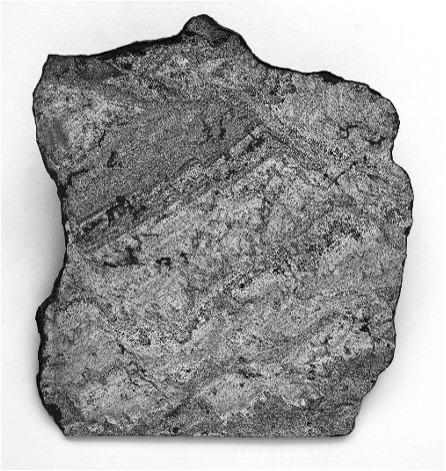
mouseover to view diagrammatic image Photos credit: Garvie et al., Icarus, vol. 292, pp. 36-47 (2017)
‘Sedimentary laminations in the Isheyevo (CH/CBb) carbonaceous chondrite formed by gentle impact-plume sweep-up’
(https://doi.org/10.1016/j.icarus.2017.03.021) The unfractionated nature of the REEs in Isheyevo, as well as the near-chondritic ratios of refractory lithophile elements, led Pack et al. (2006) to conclude that Isheyevo was formed primarily from primitive, unfractionated nebular material. This should be contrasted with the proposition that the bencubbinites formed within a metal-enriched, impact vapor plume produced by the collision of a metal-rich chondritic body and a reduced silicate body. In support of an asteroidal model is the discovery by Uymina and Grokhovsky (2006) of intermingled zoned and unzoned metal grains. The zoned grains contain small spherical inclusions consisting of a Cr–S mineral which is associated with the hydrated boundary of these grains. Diffusion-induced, oriented gradients of Ni and Cr are present within zoned grains, and a heterogeneous mixture of several FeNi-metal alloys is present as well. Isheyevo contains a significant proportion of chemically-zoned, FeNi-metal grains that likely formed during condensation from a gas. Chromium-rich troiliteBrass colored non-magnetic mineral of iron sulfide, FeS, found in a variety of meteorites. Click on Term to Read More occurs as inclusions in some metal grains, while fine-grained matrix material like that present in some CB chondrites is absent. All of these features are more consistent with a complex, multistage formation history for Isheyevo rather than a simple nebular condensation history. Raman spectra have identified the first occurrence in a carbonaceous chondrite of several high pressure phases, located within barred olivine fragments and in matrix components of the CB chondriteClass also known as bencubbinites, are named after the Bencubbin meteorite found in 1930 in Australia. Only a handful of these strange meteorites are known, all composed of >50 vol. % Ni-Fe metal, together with highly reduced silicates, and chondrules similar to those found in the CR group. Click on Term to Read More Gujba. These phases include majorite garnetMineral generally found in terrestrial metamorphic rocks, although igneous examples are not uncommon. Garnet is a significant reservoir of Al in the Earth's upper mantle. The garnet structure consists of isolated SiO4 tetrahedra bound to two cation sites. The A site holds relatively large divalent cations (Ca2+, Mg2+, Fe2+, Mn2+); the Click on Term to Read More, majorite-pyrope solid solutionCompositional variation resulting from the substitution of one ion or ionic compound for another ion or ionic compound in an isostructural material. This results in a mineral structure with specific atomic sites occupied by two or more ions or ionic groups in variable proportions. Solid solutions can be complete (with, and wadsleyiteHigh pressure polymorph of olivine, β-Mg2SiO4, found on Earth and in some meteorites. It is thought to make up 50% or more of Earth's mantle between depths of 400 and 525 km. Wadsleyite transforms into ringwoodite at high pressure, but the exact pressure depends strongly on composition. At lower pressures,, along with minor grossular-pyrope solid solution and coesiteHigh-pressure polymorph of silicon dioxide (SiO2). Has the same chemical composition as cristobalite, stishovite, seifertite and tridymite but possesses a different crystal structure. Coesite forms at intense pressures of above about 2.5 GPa (25 kbar) and temperature above about 700 °C, and was first found naturally on Earth in impact Click on Term to Read More (Weisberg and Kimura, 2010). These high pressure phases formed either through solid-state transformation of pyroxene, or through crystallizationPhysical or chemical process or action that results in the formation of regularly-shaped, -sized, and -patterned solid forms known as crystals. Click on Term to Read More from an impact-melt during a heterogeneous, planetesimal wide impact-shock event reaching minimum pressures of ~19 GPa and temperatures of ~2000°C. The investigators argue that these high pressure phases are inconsistent with the subsequent formation of chondrules within an impact plume since at such high temperatures these phases would be rapidly back-transformed to their low-temperature polymorphs. Moreover, the measured cooling rate of chondrules (ave. 100K/hr) is much slower than that at which shock veins with high pressure polymorphs would be expected to survive (~1000K/hr). Therefore, they determined that the barred chondrules and metal in CB chondrites were formed prior to the impact event which produced the high-pressure polymorphs in Gujba. Three groups of hydrous matrix lumps, or lithic clasts, have been identified in a multi-component study of Isheyevo (Bonal et al., 2008, 2010). Primary mineralogical features distinguishing the three groups are i) total hydrationReaction of a substance with water. Click on Term to Read More, ii) presence of anhydrous silicates, and iii) magnetite-free, FeNi-metal bearing. The anhydrous silicates present in the second group of clasts experienced the lowest aqueous alteration, lack magnetiteFe oxide, Fe2+Fe3+2O4, containing oxidized iron (Fe3+) found in the matrix of carbonaceous chondrites and as diagnostic component in CK chondrites. In CK chondrites, magnetite is typically chromian, containing several wt. % Cr2O3. Click on Term to Read More and carbonates, and have the lowest degree of thermal metamorphism. Cryptocrystalline microchondrules and a microCAI have been identified in this group of lithic clasts. Moreover, this clastA mineral or rock fragment embedded in another rock. Click on Term to Read More group shows isotopic evidence consistent with that of pristine chondrule fragments associated with the high-temperature component of metal-rich chondrites; i.e., they were derived from a planetesimal that was in some manner involved in the collisional disruption event that created the gas-melt plume which was the precursor to the formation of the CH/CB chondrites. Hydrous lithic clasts are primarily composed of the phyllosilicate serpentineName used for a large group of phyllosilicate minerals with the generalized formula X2-3 Y2 O5 (OH)4. Due to their various structures (meteoritics focuses primarily on (Fe, Mg)3Si2O5(OH)4), serpentine can be used to understand the chemistry and progress of aqueous alteration (hydration) of olivine, amphibole, or pyroxene dating back to Click on Term to Read More and the carbonates dolomite and magnesite, and they are comparable to petrologic typeMeasure of the degree of aqueous alteration (Types 1 and 2) and thermal metamorphism (Types 3-6) experienced by a chondritic meteorite. Type 3 chondrites are further subdivided into 3.0 through 3.9 subtypes. 1–3.05 chondrites. Hydrous lithic clasts can contain magnetite, sulfides, FeNi-metal, and even small amounts of olivine and pyroxene. These clasts exhibit various degrees of structural order in their polyaromatic carbonaceous matter component, which corresponds to low degrees of thermal metamorphism and dehydration occurring prior to incorporation of these clasts into the Isheyevo planestesimal. These hydrated clasts are chemically similar to metamorphosed CM matrix material, although some highly hydrated clasts are more similar to CI phyllosilicates (Ivanova et al, 2009). However, the mineralogy and O-isotopic composition of the carbonates in the Isheyevo clasts are distinct from those of any known aqueously altered carbonaceous chondrite including those of the CM, CI, and Tagish Lake groups, as well as from ordinary and HED meteorites (Bonal et al., 2010). The hydrous lithic clasts exhibit a wide range of isotopic compositions, all occurring together in a non-aqueously altered meteorite, and represent previously unsampled material derived from at least three unique parent bodies: Group I experienced a high degree of aqueous alteration; Group II contains anhydrous silicates; and Group III lacks magnetite and contains FeNi-metal. Briani et al. (2010) studied the structural order of the macromolecular organicPertaining to C-containing compounds. Organic compounds can be formed by both biological and non-biological (abiotic) processes. Click on Term to Read More matter present in five different lithic clasts, and demonstrated that each clast was derived from a separate parent body that experienced a range of alteration histories. These diverse clasts eventually accreted together with the other high-temperature components to form the Isheyevo parent body. The bulk O-isotopic composition of Isheyevo plots in the range of CH chondrites, along the CR–CH–CB mixing line. The vast majority of chondrules and CAIs in Isheyevo are 16O-enriched just as in CH-group components, and they plot along the CCAM line instead of the CR trend line; therefore, they represent solar nebula material rather than condensates from the impact vapor plume (Fedkin et al., 2015). The remaining 16O-depleted CAIs likely experienced remelting and isotopic exchange during accretion of the Isheyevo parent body (Krot et al., 2007). It has also been recognized that two generations of CAIs can be distinguished among the 16O-enriched group: 1) those which formed earliest, contain the most highly refractory minerals, and have minimal values of 26Al/27Al estimated to be 5×10–7; 2) those which have a less refractory nature and contain the ‘canonical’ 26Al/27Al initial ratio estimated to be 5.17(±0.10)×10–5 (Yin et al., 2008). OxygenElement that makes up 20.95 vol. % of the Earth's atmosphere at ground level, 89 wt. % of seawater and 46.6 wt. % (94 vol. %) of Earth's crust. It appears to be the third most abundant element in the universe (after H and He), but has an abundance only Click on Term to Read More and Al–Mg isotopic systematics for CH chondrites also indicate the existence of two populations of CAIs (Krot et al., 2008). The O-isotopic differences that exist between the CAIs and the magnesian cryptocrystalline and skeletal chondrules in Isheyevo indicate that each of these components formed under distinct conditions. On the other hand, the similarity in O-isotopic composition between these chondrule types in Isheyevo and the same chondrule types present in other CH and CBb chondrites suggests a genetic connection (i.e., same parent body), or at least formation within a common reservoir. It has been suggested by some investigators (e.g., Van Kooten et al. 2016) that the CAIs having the lowest abundances of 26Al might reflect a formation prior to 26Al injection into the solar nebula, rather than loss through radioactive decayProcess in which an isotope's nucleus changes ('decays') to produce another isotope. The original atom is called the 'parent' and the resulting atom, the 'daughter'. There are three modes of radioactive decay: • Emission of a particle (He nucleus) that decreases the atomic number (Z) by 2 and the atomic Click on Term to Read More and evaporation during multiple open systemDefinable part of the universe that can be open, closed, or isolated. An open system exchanges both matter and energy with its surroundings. A closed system can only exchange energy with its surroundings; it has walls through which heat can pass. An isolated system cannot exchange energy or matter with melting events in the early Solar System. In their isotopic study of the CR clan meteorites, Van Kooten et al. 2016) concluded that the precursor source material of these meteorites incorporated a significant volume (up to 50%) of primordial molecular cloud matter from the outer Solar System that was depleted in µ26Mg* and enriched in µ54Cr relative to CI chondrites; this is demonstrated in the two diagrams below. µ26Mg* and µ54Cr Compositions of Metal-rich Chondrites
(µ notation denotes deviation from terrestrial standards in parts per million)
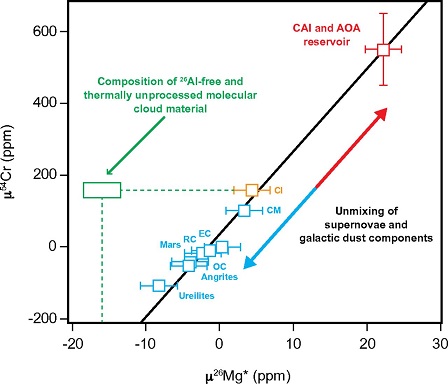
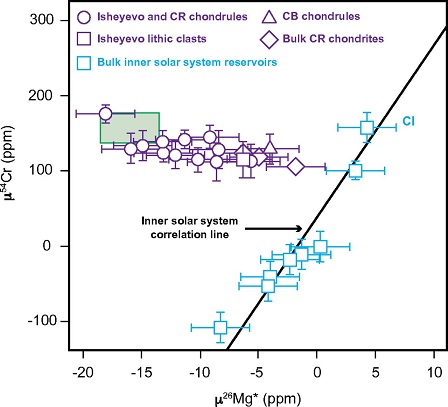
Diagrams credit: Van Kooten et al., PNAS, vol. 113, no. 8 (2016, open access link)
‘Isotopic evidence for primordial molecular cloud material in metal-rich carbonaceous chondrites’
(https://doi.org/10.1073/pnas.1518183113) Based on the K–Ar dating system, an age of ~4.3 b.y. was estimated for Isheyevo. Although this age typically represents the last degassing event, there is a strong likelihood that late thermal disturbances could have affected this chronometer. Van Kooten et al. (2016) employed 53Mn–53Cr chronometry to date the formation of secondary carbonateMineral or compound containing carbon and oxygen (i.e. calcium carbonate, CaCO3, calcite). Click on Term to Read More minerals in several hydrated lithic clasts, now constituents of the Isheyevo meteorite. This chronometer indicates that the source parent body of the hydrated lithic clasts had experienced aqueous activity 1.54 (+0.92, –1.11) m.y. later than it occurred on either the CI or CM chondrite parent bodies. This is consistent with a later accretion of the Isheyevo daughter body from an impact-generated vapor plume, while incorporating the exogenous hydrated lithic clasts. Ivanova et al. (2008) ascertained a CRE age of 34 m.y. for Isheyevo, which is in close accord with that determined for Bencubbin but significantly older than for most CH chondrites. Although the bulk meteorite is unshocked (S1), olivine grains in some chondrules exhibit features of moderate shock to stage S4 including mosaicism, planar fractures, and planar deformation features (PDFs). As with other bencubbinites and CH chondrites, Isheyevo contains an abundance of isotopically heavy N, and it contains the highest average matrix δ15N value of any meteorite—up to +1500‰ (the average composition of the solar nebula is δ15N ~ –300‰). In addition, hotspots have been identified in Isheyevo with values as high as δ15N +4000 (±1500)‰. The 15N-enrichment of the lithic clasts predates the clast accretion to the Isheyevo parent body. The main carrier phase(s) of 15N in the lithic clasts is not carbide or taeniteLess common than kamacite, both taenite and kamacite are Ni-Fe alloys found in iron meteorites. Taenite, γ-(Fe,Ni), has 27-65 wt% Ni, and forms small crystals that appear as highly reflecting thin ribbons on the etched surface of a meteorite; the name derives from the Greek word for "ribbon." Click on Term to Read More as was once thought, but instead the 15N may have been remobilized during a strong shock-melting event (Sugiura et al., 2000; Ivanova et al., 2007). In their in-depth study of Bencubbin, Perron et al. (2008) proposed that water and 15N-bearing organic compounds were degassed from the hydrated lithic clasts during the impact of a chondritic object(s). These hydrated lithic clasts later agglomerated onto the CB/CH/Isheyevo parent body during the initial accretionary stage. Conversely, in their scanning ionAtom with a net electrical charge because it has lost, or gained, one or more electrons relative to the number possessed by a neutral atom of the same element. A positively charged ion (cation) has fewer electrons than a neutral atom; a negatively charged ion (anion) has more. Click on Term to Read More study of Isheyevo lithic clasts, Bonal et al. (2008) have resolved the presence of isotopically anomalous organic compounds, suggesting that this may be the source of the abundant 15N. In a similar conclusion based on studies of a hydrated lithic clast, Leitner et al. (2010, 2011) identified a presolar silicate grain of a type associated with a core-collapse supernovaStellar explosion that expels much or all of the stellar material with great force, driving a blast wave into the surrounding space, and leaving a supernova remnant. Supernovae are classified based on the presence or absence of features in their optical spectra taken near maximum light. They were first categorized Click on Term to Read More which was found to contain 15N-rich material (δ15N = 1400‰ and higher). The presolar grainsMineral grains that formed before our solar system. These tiny crystalline grains are typically found in the fine-grained matrix of chondritic (primitive) meteorites. Most grains probably formed in supernovae or the stellar outflows of red giant (AGB) stars before being incorporated in the molecular cloud from which the solar system Click on Term to Read More were injected ~100 AUThe astronomical unit for length is described as the "mean" distance (average of aphelion and perihelion distances) between the Earth and the Sun. Though most references state the value for 1 AU to be approximately 150 million kilometers, the currently accepted precise value for the AU is 149,597,870.66 km. The Click on Term to Read More from the solar nebula (Sugiura and Fujiya, 2011), at an abundance determined to be ~10 ppmParts per million (106). Click on Term to Read More. These findings support the theory of surviving protosolar cloud material as the source of the 15N-anomaly. Other studies attribute the source of the heavy N to N2 self-shielding or low-temperature ion-molecule reactions in the protosolar molecular cloud or the protoplanetary disk. The heavy N may have been carried in a phyllosilicate layer or in amorphousMaterial without the regular, ordered structure of crystalline solids. Amorphous substances, like glass, lack a definite repeating pattern in their atomic structures (crystallinity). There may be small regions of order, but, overall there is disorder. Click on Term to Read More ferrihydrite and redistributed/diluted by aqueous alteration processes to produce Group I clasts (Bonal et al. (2010). Isheyevo has undergone only minor terrestrial weathering (W1). This meteorite demonstrates characteristics of a transitional member of the CR clan, which allows mineral and chemical comparisons to be made between all of the members. The specimen of Isheyevo shown above is a 2.1 g slice (photography courtesy of Sergey Vasiliev). The photo below shows the detailed cut face of a 253 g slice, courtesy of the J. Piatek Collection.
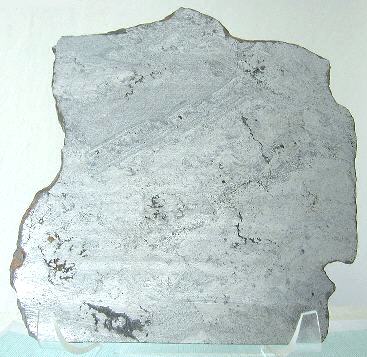
Photo courtesy of Dr. J. Piatek Meteorite Collection






